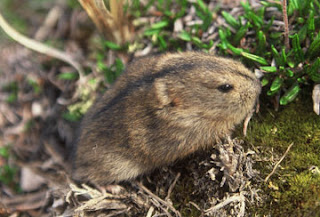Animal Wildlife | Lemming | The lemming is a tiny rodent that is found in or near the Arctic Circle and are thought to be related to voles and muskrats. The smallest species of lemming is the wood lemming measuring around 8 cm. The Norwegian lemming is roughly three times the size of a wood lemming and is one of the largest species of lemming. Lemmings do not hibernate and instead endure the tough Arctic winters, with the lemming having special protection from the cold from its thick fur. The lemmings spend the winter searching for bulbs and shoots that are often buried beneath the snow. Lemmings are surprisingly solitary animals, only coming together to mate then separating again. Wild lemmings are thought to never get older than a couple of years due the harsh conditions in their natural habitat and the small and very edible size of the lemming. The lemming is easy prey for most meat-eating mammals and birds.
The theory that older lemmings consciously jump off cliffs in large numbers in order to let the younger lemming generations have full access to food and shelter etc is a myth. This may have originated from the mass migration of the Scandinavian lemming when food becomes scarce, that run in their hundreds through the surrounding terrain in search of food, with a few unlucky individuals finding their way off cliffs. There are nearly 30 different species of lemming found around the Arctic Circle, from Alaska to Siberia. Although many different species of lemming have been recognised, all lemming species are pretty much the same apart from where they live and so the lemming species tend to differ most from one another based on what the lemmings can find to eat.
Lemmings have small, stout bodies and short limbs, ears and tail in order to allow the lemming to conserve heat more easily in the bitter Arctic winters. Lemmings also have sharp little teeth which helps the lemmings to gnaw through tangles of roots. Female lemmings give birth to the baby lemmings after a gestation period of around three weeks. Baby lemmings are born in burrows under the snow which helps to keep the baby lemmings warm and away from the Arctic winter. The mother lemming gives birth to around 7 baby lemmings and feeds the baby lemmings on her milk until they are big enough and strong enough to start looking for food by themselves. The food that lemmings eat is not very nutritious, so lemmings must eat lots of it. Lemmings spend around 6 hours a day searching for food and have breaks in between hunting, during which the lemmings rest. Lemmings reside in burrows beneath the snow to keep them warm and safe from predators that lurk on the surface of the snow.
Tags: rodent removal atlanta, rodent san diego, rodent removal chicago, rodent removal houston, rodent removal cost, rodent extermination, rodent exterminator, rodent exterminator cost, squirrel rodent, rodent removal, rodent exterminators, rodent inspection, louisiana rodent, rodent pest management, misdiagnosis rodent ulcer, rodent extermination methods, rodent management





0 Response to "Lemming"
Post a Comment